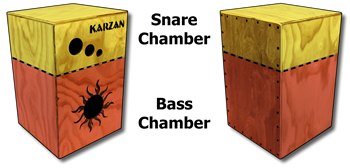



You'll need to undo the horizontal rope weaving that wraps around your drum, then pull the slack out of the vertical sections of rope, then re-weave the horizontal wraps. Watch the videos for a complete demonstration.
After you have received your brand-new KARZAN Ashiko you can expect to need to retighten the head several times, with progressively longer periods of time between. There is no strict timeline, you should basically do it as needed... you'll be able to hear the tone drop. We losely follow this schedule with a new drum: after about 7 days, then 14 days later, then 30 days. After the first year the heads and ropes seem to stabilize and can go years between tightening, depending on use and storage conditions.
Our Ashiko drums are priced using Cedar or Pine as a base-line material. Both of them are comparatively affordable, and they are light weight and resonant. We also have access to a lot of different kinds of wood, such as black walnut, birch, mahogany, pecan, African rosewood, zebra wood, leopard wood, purple heart, and many more. The exotic hardwoods from Africa and South America can significantly increase the price, often as much as $100 or more. Please contact us for a quote if you have something special in mind.
A cajon (pronounced ka-HON) is a box-shaped percussion instrument originally from Peru. It is played by tapping and slapping the playing surface, called the tapa, with hands, fingers, and sometimes brushes or soft mallets. Originally cajons were only wooden boxes or crates used to ship and store items, but over time they have evolved into fairly sophisticated instruments that include snare wire, rattles, bass pedals, and even audio pickups that allow them to be amplified, broadcast or recorded.
 Many cajons are made as a simple single-chamber box. We have designed our newest model of cajon with an internal divider that splits the box into two different chambers. The smaller upper chamber has a snare installed, and the lower chamber does not, resulting in two distinct and different sounds without having to fumble around with controls on the side of the drum to turn your snare on and off while in the middle of doing your groove-thang. Watch it in action with this demo video [link].
Many cajons are made as a simple single-chamber box. We have designed our newest model of cajon with an internal divider that splits the box into two different chambers. The smaller upper chamber has a snare installed, and the lower chamber does not, resulting in two distinct and different sounds without having to fumble around with controls on the side of the drum to turn your snare on and off while in the middle of doing your groove-thang. Watch it in action with this demo video [link].
Yes, you can request specific artwork stencil-painted on an Ashiko or Cajon. Depending on the size and complexity of the artwork there may be an additional fee. Contact us for a quote.
If you don't find your question answered above, please submit it to us using the form below.